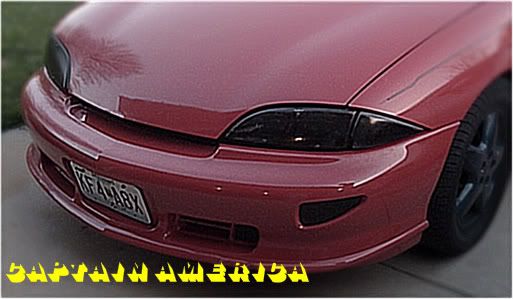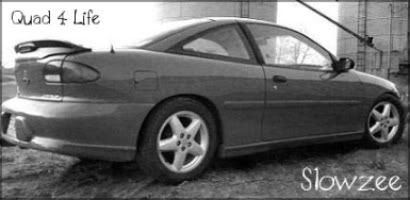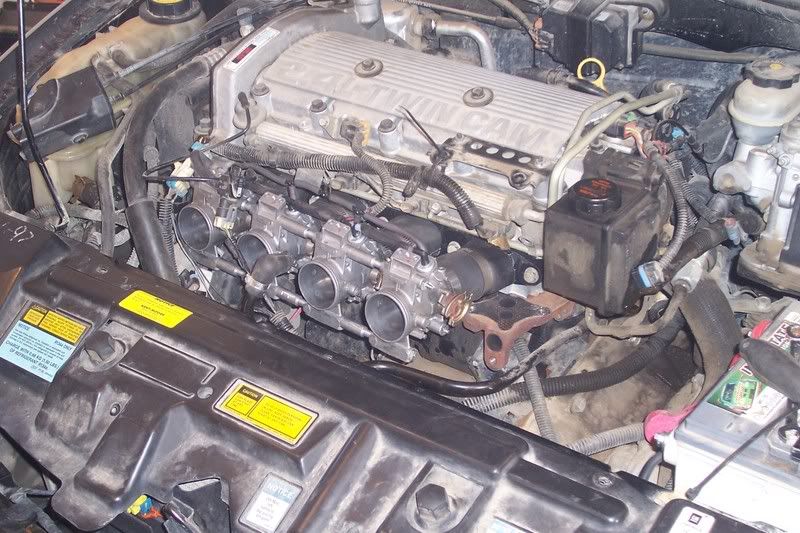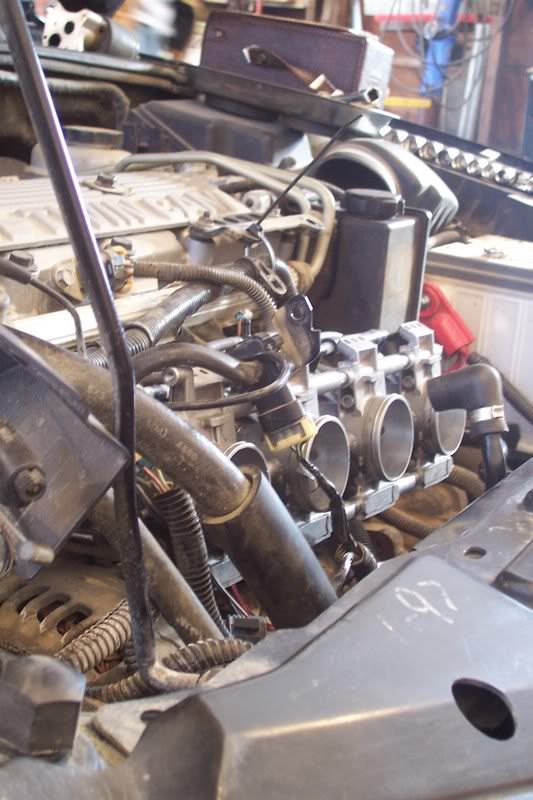There have been attempts but I cant think of anyone currently running them. Tuning is a bit of a pain. I do plan on running some by next summer though.

quad4rods.com also sells parts to run itbs for the quad 4 and the eco
RIP Cpl Derek Kerns And Cpl Robby Reyes
24th MEU VMM-261 (REIN) V22 Crewchiefs
11 April 2012 Morocco (African Lion)
Hey!
These sure look like ITBs to me.

i have them there collecting dust on my bench

MP-62 Intercooled 2.9" Pulley
Wow lol those are cool but I can't see spending $1000 on them.

Ethan Duke wrote:Wow lol those are cool but I can't see spending $1000 on them.
haven't done much research on the topic then have you? $1k for ITBs that aren't retrofitted from a motorcycle and aren't connected to the manifold using silicone couplers (no offense to paul) is cheap.
the quad 4 rods setup is the only off-the-shelf setup I know of for the 2.4
kinsler injection makes one for the eco, and its over $2k
quality parts = money. kinsler designs their ITBs to your particular engine, so throttle diameter, velocity stack, and runner volume and length are all tailored to your exact engine's needs.. very important stuff when it comes to ITBs.
big cams are a must. exhaust work is a must. a lot of people say you need high compression too but eh
i was thinking of using a Q4R manifold (they make one for the eco that adapts to a DCOE carb pattern), then going to TWM motorsports and buying DCOE throttle bodies and bam... ITB kit for the eco that doesn't use silicone.
but as was mentioned, tuning ITBs (especially if you think you're gonna drive on the street) is apparently pretty difficult. I don't have any first hand experience doing so, but per % of throttle input, airflow is increase tremendously.. so tuning partial throttle is apparently very difficult.
also, MAP signal is reduced because there is no longer a common plenum for engine vacuum to accumulate. you could solve this by using a vacuum manifold (for the booster and fpr and anything else requiring vacuum) tho.

I understand quality=cost but it seems like money could be spent much better else where. ITBs are cool but it seems like with a proper manifold/TB/intake combo you could just as good if not better gains for alot less and alot easier.

The Q4R one appears to have a common vacuum area PJ.
Im just trying to imagine how sick some ITBs would look sticking out of the back of my 2200.

why couldnt someone design a itb and have a plenum before the tbs but with a large enough opening for 0 lose to the itbs. this way we could use all the vacume lines and one filter.

brodycog wrote:why couldnt someone design a itb and have a plenum before the tbs but with a large enough opening for 0 lose to the itbs. this way we could use all the vacume lines and one filter.
You will maintain atmospheric pressure in the plenum at all times in a NA engine. It is only after the throttle plate where you see a pressure drop. The difficulty with the ITB's, is you have a pressure wave that constantly resonates back and forth down the runner, so getting a reliable map reading can be tricky...hence, you use a vacuum manifold that averages all 4 runners. Turbocharged engines with ITB's, however, will use a common plenum like you propose.
I have no signiture
brodycog wrote:why couldnt someone design a itb and have a plenum before the tbs but with a large enough opening for 0 lose to the itbs. this way we could use all the vacume lines and one filter.
most have ports that can be used to connect to a common volume, but the whole point of ITBs is to give each cylinder its own individual runner. making a common area large enough for them that will stabilize the MAP signal defeats the purpose.
ethan duke wrote:I understand quality=cost but it seems like money could be spent much better else where. ITBs are cool but it seems like with a proper manifold/TB/intake combo you could just as good if not better gains for alot less and alot easier
ITBs are really the last step for a true all motor build. Not just people who leave of forced induction and call their car 'n/a'. By the time you get to ITBs, there's so much more money into the enging already that the cost won't seem that bad.
machine work to the bottom end and head is where the dime is usually best spent depending on your goals. If you're looking for cost vs. horsepower, all motor is never the way to go. Our cars aren't that light to begin with, and it takes a lot of work and cash to get serious power out of the engines.
Our heads don't flow that great, the angle of our ports are shallow, we don't have a lot of high compression piston options outside of custom, we don't have GOOD header designs available, the F23 trans isn't that great with gearing.. its tough building a fast all motor jbody.
can you still have fun n/a? absolutely. 13 seconds is achievable on any base model J with a twin cam engine, whether it be 2.4 or ecotec. But taking it to the next step (the step that would probably NEED ITBs) would be very tough, lots of custom parts and at the end of the day, most people here would be disappointed with the amount of power that would result from all the $$$ spent.

^^^i think itb's are out of the reach of doing any good for 99.9 percent of the people building an n/a car here.

i personally dont see the need for ITB's... id rather have a plenum and one big ass TB.
a lot of the honda build's over on honda tech actually do better in some cases with a plenum.
 If it takes forever.... I will die trying. Underdog Racing
If it takes forever.... I will die trying. Underdog Racing
Story goes like this....
Put ITBs on my LD9, I was revving it so high to try and get into the power band of the ITBs, that it spun the #3 bearing and hung a rod out the block....
The End

Slowzee wrote:Story goes like this....
Put ITBs on my LD9, I was revving it so high to try and get into the power band of the ITBs, that it spun the #3 bearing and hung a rod out the block....
The End
which is why runner length is so important... the length/volume of the runner has to be calculated to where you want the powerband to be.
longer runner = lower power band
there's tons of calculators and formulas that can be found online to help figure this stuff out... but it still isn't easy to do.

This is the one time and the only time where I say our cars have it good for tuning, we're already alpha-n with our computers, we're already set up computer wise to run ITB's. Alpha-n's only purpose as a tuning system is ITB's (or cars with jumbo hugeomatic cams that have vac signal issues).
1994 Saturn SL2 Home Coming Edition: backup car
2002 Chevy Cavalier LS Sport Coupe: In a Junk Yard
1995 Mazda Miata R-package Class=STR
Sponsored by:
Kronos Performance
WPI Class of '12 Mechanical Engineering
WPI SAE Risk and Sustainability Management Officer
DaFlyinSkwirl (Pj) v2.0 wrote:Slowzee wrote:Story goes like this....
Put ITBs on my LD9, I was revving it so high to try and get into the power band of the ITBs, that it spun the #3 bearing and hung a rod out the block....
The End
which is why runner length is so important... the length/volume of the runner has to be calculated to where you want the powerband to be.
longer runner = lower power band
there's tons of calculators and formulas that can be found online to help figure this stuff out... but it still isn't easy to do.
lenght and diameter just like an exhaust runner

So basically investing some time and money into a custom intake manifold would be more beneficial.

Ethan Duke wrote:So basically investing some time and money into a custom intake manifold would be more beneficial.
so long as it was designed right, I would have to say yes.
ITBs work best without a filter element. So if you plan on driving on the street, something getting sucked into the engine is a pretty big risk.
I've seen people on honda-tech complaining about losing as much as 15whp when putting filters on the ITBs instead of leaving them wide open.
a common plenum manifold with tuned length runners is ideal for tight engine bays (like ours) and for street driven cars.






















